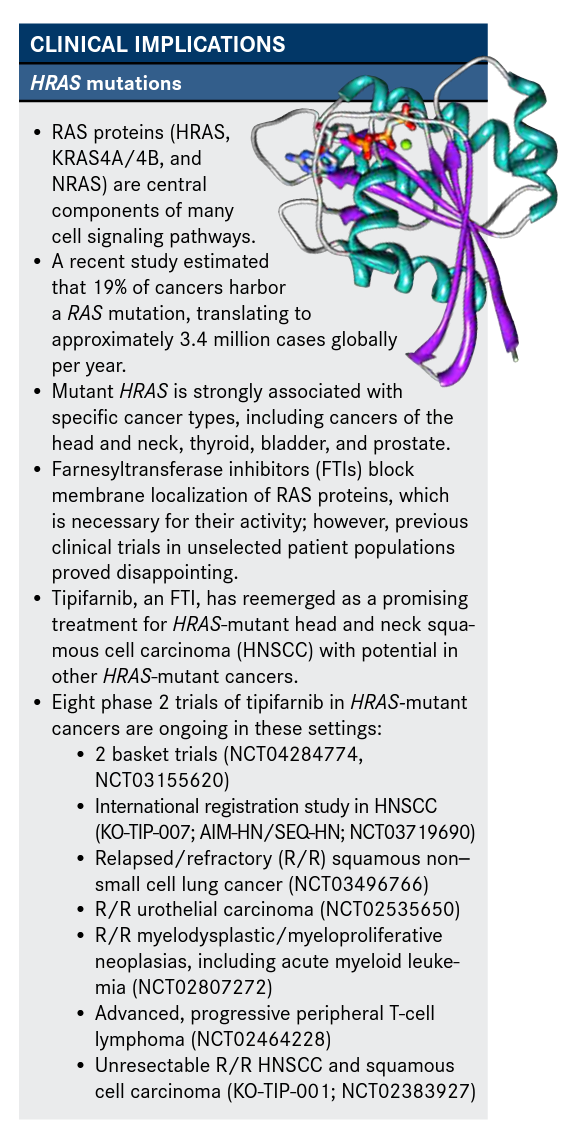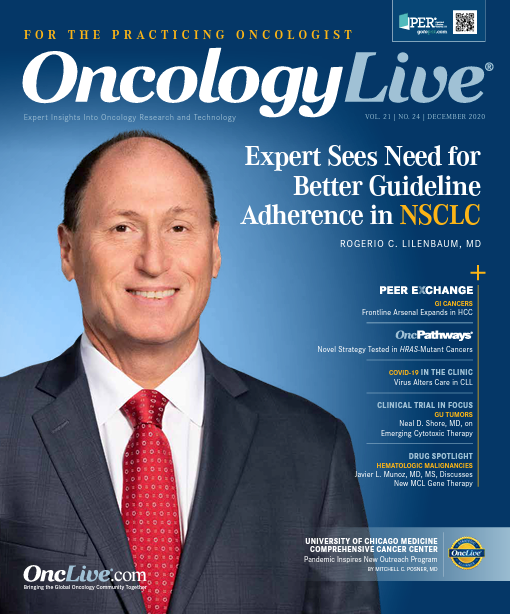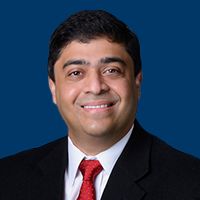Publication
Article
Novel Strategy Gains Traction Against HRAS-Mutant Cancers
Author(s):
Despite decades of research and drug development, however, the therapeutic utility of targeting RAS is limited to ruling out treatment with certain drugs in patients without RAS mutations.

More than a quarter of a million new cases of RAS-mutant cancer are diagnosed each year in the United States,1 making the pathway a high-priority target for cancer therapy. Despite decades of research and drug development, however, the therapeutic utility of targeting RAS is limited to ruling out treatment with certain drugs in patients without RAS mutations.2,3
The reasons for failure of RAS-targeted drugs are multifaceted, but an emerging appreciation of the complexities of RAS-mediated signal transduction has recently fed a growing consensus that a single drug that would successfully treat all RAS-mutant cancers is unlikely. New treatment strategies have begun to challenge the perception of RAS as “undruggable.”3-6
The discovery of inhibitors specific to KRAS mutations has generated fresh optimism about direct targeting of KRAS for a subset of patients. Meanwhile, patients with HRAS-mutant cancers could benefit from the resurrection of farnesyltransferase inhibitors (FTIs), which block the membrane association of RAS necessary for its activity.3,4,6,7
Although FTIs were previously tested unsuccessfully in KRAS-driven tumors,7,8 the FTI tipifarnib has been given another chance by Kura Oncology.9 In a presentation at the 2020 American Society of Clinical Oncology (ASCO) Virtual Scientific Program, phase 2 trial results for patients with HRAS-mutant head and neck squamous cell carcinoma (HNSCC) highlighted the potential of tipifarnib.10 The FDA granted fast track designation to tipifarnib in this treatment setting,11 and numerous clinical trials for tipifarnib are ongoing in HNSCC and other malignancies.
FIGURE. HRAS Is Among RAS Family Members Involved in Signaling Networks4,7,12

A Molecular Hub
RAS proteins, which exist as 4 isoforms (HRAS, NRAS, and 2 KRAS splice variants), are guanosine triphosphate (GTP)–hydrolyzing enzymes (GTPases) that cycle between a GTP-bound active form and a guanosine diphosphate (GDP)–bound inactive form, often likened to a molecular “on-off” switch. In their active form, RAS proteins serve as a molecular hub, transmitting signals from membrane-bound receptors into the cell by activating a variety of downstream pathways that regulate numerous cellular processes (FIGURE).4,7,12
RAS activity is tightly regulated in several ways. In the absence of an extracellular signal, RAS cycles very slowly between the GDP- and GTP-bound states, but following activation of upstream growth factor receptors—EGFR being the best characterized—guanine nucleotide exchange factors (GEFs) accelerate the GDP-to-GTP exchange and activate RAS.4,7,12
Cessation of downstream effector pathway signaling triggers the reverse reaction, which is promoted by GTPase-activating proteins that boost the intrinsic GTP-hydrolyzing activity of the RAS proteins.4,7,12
Historically, their shared structural and mechanistic features led to the misconception that the 4 RAS proteins were functionally redundant.7 Over the decades, the different isoforms have been shown to diverge in several important ways, beginning with their regulation by posttranslational modifications, which control the RAS proteins’ association with cell membranes, where they can interact with downstream effectors. Although the different RAS proteins are identical in most of their amino acid sequence, they diverge most in the aptly named hypervariable region (HVR). The HVR contains a motif that is targeted for prenylation by the farnesyltransferase enzyme.3,7,13
Prenylation, followed by further modification of the HVR by 2 additional enzymes, makes the carboxy-terminus hydrophobic, allowing RAS to be inserted into cellular membranes. A final modification occurs at a site in the HVR upstream of the prenylation target sequence. The type of modification, dubbed the second signal, is unique to the specific RAS isoform; for example, HRAS and NRAS undergo palmitoylation that further facilitates their membrane localization.3,7,13
Of the downstream effectors bound by activated RAS, the most extensively studied is RAF kinase, part of the MAPK pathway; other well-known effectors include PI3K. Isoform-specific differences in RAS modif ication and regulation lead to activation of distinct effector pathways. For example, HRAS activates the PI3K pathway more strongly than either KRAS or NRAS. Ultimately, these signaling pathways culminate in the activation of transcription factors in the nucleus that promote gene expression to coordinate a wide variety of cellular responses, such as cell growth, survival, and proliferation. These processes, when uncontrolled, can promote oncogenesis.3-5
Oncogenic RAS
Orthologues of the RAS genes were originally identified as oncogenes that underlie the ability of certain viruses to cause cancer in rats. Seminal studies in the 1980s demonstrated that RAS genes are a vital part of the normal human genome that, when aberrantly activated, are capable of causing cancer. Since then, mutated forms of RAS proteins and members of the broader RAS superfamily have been recognized as some of the main contributors to human cancer.7,13,14
One of the most common mechanisms of oncogenic RAS signaling activation is through mutations in the RAS genes themselves; however, a lack of consensus remains regarding the frequency of RAS mutations in cancer. This disparity was highlighted by a comparison of 4 major cancer mutation databases: the Catalogue of Somatic Mutations in Cancer, The Cancer Genome Atlas, Memorial Sloan Kettering’s cBioPortal for Cancer Genomics, and the International Cancer Genome Consortium. Despite considerable overlap in their data sets, these databases showed RAS mutation rates of 24.8%, 11.6%, 17.5%, and 19.3%, respectively.1
In a recent meta-analysis, the mutation frequencies from across these data sets were used to estimate the global RAS disease burden. The authors concluded that approximately 19% of cancers harbor a RAS mutation, translating to approximately 260,000 new cases per year in the United States and 3.4 million cases globally.1
Despite their similarities, the genes encoding the different RAS isoforms do not have equal mutation rates. Overall, KRAS mutations are the most common (found in ≈ 75% of RAS-mutant cancers), followed by NRAS (≈ 17%); HRAS mutations, the rarest (≈ 7%), translate into approximately 230,000 cases of HRAS-mutant cancer globally each year.1 There is also an isoform- and cancer typedependent distribution of RAS mutations; for example, HRAS, KRAS, and NRAS are most frequently altered in HNSCC, lung cancer, and melanoma, respectively.7,15
RAS mutations, which are typically missense, most often occur at several hotspots common to all 4 isoforms: the glycine residues at positions 12 (G12) and 13 (G13) and the glutamine at position 61 (Q61). Each of these mutations drives constitutive activation of the RAS protein, albeit in slightly different ways. The relative frequencies of mutations at these 3 hotspots vary by isoform; whereas 81% of KRAS mutations occur at G12 and 62% of NRAS at Q61, the different hotspots are approximately equally likely to be altered in HRAS-mutant cancers.1,4,13,15
The clinical implications of the HRAS mutation

Reviving FTIs in HRAS-Mutant Cancer
Despite their importance in human cancer, oncogenic RAS mutations have long been considered undruggable. Hopes of directly targeting the proteins were abandoned early because of the lack of sites amenable to small-molecule inhibitor binding. Recently, those hopes were renewed, with the development of KRAS G12C–specific inhibitors.3-7
These drugs are active only in patients with this specific mutation, but they highlight a growing consensus that the way forward for RAS targeting lies not in a single overarching strategy but in exploiting the unique nature of different types of RAS mutations, assisted by novel clinical trial designs, such as basket trials, that recruit patients with rarer mutations, such as HRAS alterations.
Over the years, a range of other strategies have been tested, including using FTIs to disrupt trafficking of RAS proteins to the membrane. Clinical trials began with tipifarnib several decades ago, but development ultimately fizzled. The failure of these early trials was largely due to resistance driven by alternative prenylation; when farnesylation was inhibited, cells used the geranylgeranyltransferase enzyme instead.4,7-9
Blocked farnesylation of HRAS cannot be rescued in this manner, which may make HRAS-mutant cancers uniquely susceptible to FTIs.7 Kura Oncology is betting on this premise; it acquired the oncology rights to tipifarnib in 2015 and is currently testing it in a range of HRAS-mutant tumors.9
The ongoing phase 2 KO-TIP-001 trial is testing tipifarnib in patients with HRAS-mutant advanced solid tumors for whom no curative therapy is available (NCT02383927). The study was originally designed to enroll patients with thyroid cancer (cohort 1) or other solid tumors (cohort 2).10
According to a presentation of preliminary results at the European Society for Molecular Oncology meeting in 2018,16 the study was amended to limit cohort 2 to patients with HNSCC and to add a third cohort of patients with other types of squamous cell carcinoma. Furthermore, only patients with a high mutant-HRAS variant allele frequency (VAF > 20%) were enrolled, and the dose was amended from 900 mg twice daily to 600 mg twice daily on a 1-week-on, 1-week-off schedule in 28-day cycles.10
At the 2020 ASCO meeting, results were presented for 21 patients with HNSCC who met the VAF criterion and had been treated to date in the KO-TIP-001 trial. Patients had received a median of 2 prior systemic regimens, including immunotherapy, chemotherapy, and/or cetuximab (Erbitux), and had experienced no response on their last therapy prior to study entry.10
Among 18 evaluable patients, the overall response rate (ORR) was 50% (95% CI, 26%-74%). Median progression-free survival (mPFS) was 5.9 months (95% CI, 3.5-19.2), and median overall survival (mOS) was 15.4 months (95% CI, 7.0-46.4).10
Results for 13 patients with recurrent/ metastatic salivary gland tumors who had been treated in the original cohort 2 of this trial or an extended access program were also presented. Among 12 evaluable patients, there was 1 objective response— a partial response ongoing at 14 months— and 7 patients experienced stable disease (SD) with a median duration of 9 months, 5 of whom had greater than 10% tumor regression.10
Kura Oncology received fast track designation for tipifarnib for the treatment of HRAS-mutant HNSCC in late 2019, and an international registration study in this indication is currently recruiting patients.11 Details of the KO-TIP-007 trial (AIM-HN/ SEQ-HN; NCT03719690), designed to include patients in 2 cohorts at 94 sites globally, were provided at the 2020 ASCO meeting.17
The AIM-HN cohort aims to enroll at least 59 patients with HRAS-mutant cancer, who will be treated with tipifarnib 600 mg twice daily in 28-day cycles on a 1-week-on, 1-week-off schedule. SEQ-HN is an observational cohort planning to include 225 patients with wild-type HRAS as controls, who will receive standard of care. All patients have previously received treatment, including at least 1 line of platinum-based chemotherapy for AIM-HN. A subset of patients from SEQ-HN will be matched to those treated in AIM-HN to compare the effect of HRAS mutation on responses to first-line HNSCC therapy. The company expects the trial to complete enrollment in the first quarter of 2021.11,17
Tipifarnib has also shown promise in patients with HRAS-mutant metastatic urothelial carcinoma. In a phase 2 clinical trial (NCT02535650), patients received tipifarnib 900 mg twice daily on a 1-week-on, 1-week-off schedule in 28-day cycles. Among 21 patients, 14 had an HRAS mutation (G13R, n = 7; Q61R, n = 4; G12S, n = 2; G12C, n = 1). The remaining 7 patients had wild-type HRAS but carried a polymorphism in STK11, which encodes a farnesylated tumor suppressor and was investigated as a possible target of tipifarnib.18
Patients had received a median of 2 prior lines of chemotherapy, and 2 patients had received prior immunotherapy. Investigators observed 5 clinical responses among 16 evaluable patients, for an ORR of 24%; the median duration of response was 8.8 months (95% CI, 3.8-13.8). In addition, 4 patients achieved SD. mPFS and mOS were 4.7 months (95% CI, 2.5-5.6) and 6.1 months (95% CI, 5.0-7.2), respectively.18
Only 1 responder had an STK11 polymorphism, and this patient was later found to have a nonsense mutation in HRAS; thus, there were no responses in patients with wild-type HRAS. The investigators concluded that tipifarnib is not effective in patients with the STK11 polymorphism and/ or wild-type HRAS.18
References
- Prior IA, Hood FE, Hartley JL. The frequency of Ras mutations in cancer. Cancer Res. 2020;80(14):2969-2974. doi:10.1158/0008-5472.CAN-19-3682
- List of cleared or approved companion diagnostic devices (in vitro and imaging tools). FDA. Updated September 10, 2020. Accessed October 21, 2020. https://www.fda.gov/medical-devices/vitro-diagnostics/list-cleared-or-approved-companion-diagnostic-devices-vitro-and-imaging-tools
- Degirmenci U, Wang M, Hu J. Targeting aberrant RAS/RAF/MEK/ERK signaling for cancer therapy. Cells. 2020;9(1). doi:10.3390/cells9010198
- Zuberi M, Khan I, O’Bryan JP. Inhibition of RAS: proven and potential vulnerabilities. Biochem Soc Trans. Published online September 1, 2020. doi:10.1042/BST20190023
- Moore AR, Rosenberg SC, McCormick F, Malek S. RAS-targeted therapies: is the undruggable drugged? Nat Rev Drug Discov. 2020;19(8):533-552. Published correction appears in Nat Rev Drug Discov. Published online October 20, 2020.
- Stalnecker CA, Der CJ. RAS, wanted dead or alive: advances in targeting RAS mutant cancers. Sci Signal. 2020;13(624): eaay6013. doi:10.1126/scisignal.aay6013
- Shu L, Wang D, Saba NF, Chen ZG. A historic perspective and overview of H-Ras structure, oncogenicity, and targeting. Mol Cancer Ther. 2020;19(4):999-1007. doi:10.1158/1535-7163.MCT-19-0660
- Gilardi M, Wang Z, Proietto M, et al. Tipifarnib as a precision therapy for HRAS-mutant head and neck squamous cell carcinomas. Mol Cancer Ther. 2020;19(9):1784-1796. doi:10.1158/1535-7163.MCT-19-0958
- OncoDNA, Kura Oncology sign patient enrollment pact. News release. Kura Oncology. May 22, 2018. Accessed October 19, 2020. https://ir.kuraoncology.com/news-releases/news-release-details/oncodna-announces-screening-collaboration-kura-oncology
- Ho AL, Hanna GJ, Scholz CR, Gualberto A, Park SH. Preliminary activity of tipifarnib in tumors of the head and neck, salivary gland and urothelial tract with HRAS mutations. J Clin Oncol. 2020;38(suppl 15):6504. doi:10.1200/JCO.2020.38.15_suppl.6504
- Kura Oncology receives fast track designation for tipifarnib in HRAS mutant HNSCC and provides enrollment guidance for AIM-HN trial. News release. Kura Oncology. December 19, 2019. Accessed October 13, 2020. https://ir.kuraoncology.com/news-releases/news-release-details/kura-oncology-receives-fast-track-designation-tipifarnib-hras
- Simanshu DK, Nissley DV, McCormick F. RAS proteins and their regulators in human disease. Cell. 2017;170(1):17-33. doi:10.1016/j.cell.2017.06.009
- Gimple RC, Wang X. RAS: striking at the core of the oncogenic circuitry. Front Oncol. 2019;9:965. doi:10.3389/fonc.2019.00965
- Murugan AK, Grieco M, Tsuchida N. RAS mutations in human cancers: roles in precision medicine. Semin Cancer Biol. 2019;59:23-35. doi:10.1016/j.semcancer.2019.06.007
- Dunnett-Kane V, Burkitt-Wright E, Blackhall FH, Malliri A, Evans DG, Lindsay CR. Germline and sporadic cancers driven by the RAS pathway: parallels and contrasts. Ann Oncol. 2020;31(7):873-883. doi:10.1016/j.annonc.2020.03.291
- Ho AL, Chau N, Bauman J, et al. Preliminary results from a phase II trial of tipifarnib in squamous cell carcinomas (SCCs) with HRAS mutations. Ann Oncol. 2018;29(suppl 8):viii373. doi:10.1093/annonc/mdy287.002
- Haddad RI, Harrington KJ, Licitra LF, et al. The AIM-HN and SEQ-HN study: a pivotal study evaluating the efficacy of tipifarnib in patients with head and neck squamous cell carcinoma (HNSCC) with hras mutations (AIM-HN) and the impact of hras mutations on response to first line systemic therapies for HNSCC (SEQ-HN). J Clin Oncol. 2020;38(suppl 15):TPS6593. doi:10.1200/JCO.2020.38.15_suppl.TPS6593
- Lee HW, Sa JK, Gualberto A, et al. A phase II trial of tipifarnib for patients with previously treated, metastatic urothelial carcinoma harboring HRAS mutations. Clin Cancer Res. 2020;26(19):5113-5119. doi:10.1158/1078-0432.CCR-20-1246









